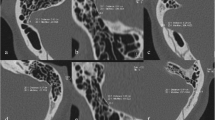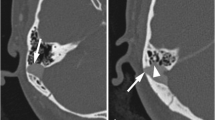Abstract
Introduction
Tinnitus is a symptom commonly associated with idiopathic intracranial hypertension (IIH) that can have a profound effect on quality of life. We aim to determine tinnitus symptom response after dural venous sinus stenting (DVSS) or CSF diversion with a shunt, in patients with both pulsatile (PT) and non-pulsatile tinnitus (NPT).
Methods
Single-centre cohort of IIH patients (2006–2016) who underwent 24-h ICP monitoring (ICPM). An un-paired t test compared ICP and pulse amplitude (PA) values in IIH patients with PT vs. NPT.
Results
We identified 59 patients with IIH (56 F:3 M), mean age 32.5 ± 9.49 years, 14 of whom suffered from tinnitus. Of these 14, seven reported PT and seven reported NPT. Patients with tinnitus had a mean 24-h ICP and PA of 9.09 ± 5.25 mmHg and 6.05 ± 1.07 mmHg respectively. All 7 patients with PT showed symptom improvement or resolution after DVSS (n = 4), secondary DVSS (n = 2) or shunting (n = 1). In contrast, of the 7 with NPT, only 1 improved post intervention (DVSS), despite 2 patients having shunts and 5 having DVSS.
Conclusions
NPT and PT were equally as common in our group of IIH patients. DVSS appears to be an effective management option for IIH patients with a clear history of pulsatile tinnitus. However, non-pulsatile tinnitus was more persistent and did not respond well to either DVSS or CSF diversion.


Similar content being viewed by others
References
Friedman DI, Liu GT, Digre KB (2013) Revised diagnostic criteria for the pseudotumor cerebri syndrome in adults and children. Neurology 81(13):1159–1165
Radhakrishnan K, Ahlskog JE, Cross SA, Kurland LT, O'Fallon WM (1993) Idiopathic intracranial hypertension (pseudotumor cerebri). Descriptive epidemiology in Rochester, Minn, 1976 to 1990. Arch Neurol 50:78–80
Boddu S, Dinkin M, Suurna M, Hannsgen K, Bui X, Patsalides A (2016) Resolution of pulsatile tinnitus after venous sinus stenting in patients with idiopathic intracranial hypertension. PLoS One 11(10):e0164466
Rudnick E, Sismanis A (2005) Pulsatile tinnitus and spontaneous cerebrospinal fluid rhinorrhea: indicators of benign intracranial hypertension syndrome. Otol Neurotol 26(2):166–168
Asif H, Craven CL, Siddiqui AH, Shah SN, Matloob SA, Thorne L, Robertson F, Watkins LD, Toma AK (2017) Idiopathic intracranial hypertension: 120-day clinical, radiological, and manometric outcomes after stent insertion into the dural venous sinus. J Neurosurg 6:1–9
Harvey RS, Hertzano R, Kelman SE, Eisman DJ (2014) Pulse-synchronous tinnitus and sigmoid sinus wall anomalies: descriptive epidemiology and the idiopathic intracranial hypertension patient population. Otol Neurotol 35(1):7–15
Higgins JN, Owler BK, Cousins C, Pickard JD (2002) Venous sinus stenting for refractory benign intracranial hypertension. Lancet 359(9302):228–230
Sismanis A (2003) Pulsatile tinnitus. Otolaryngol Clin N Am 36(2):389–402
Erlandsson SI, Hallberg LR (2000) Prediction of quality of life in patients with tinnitus. Br J Audiol 34(1):1–20
Liu Z, Dong C, Wang X, Han X, Zhao P, Lv H, Li Q, Wang Z (2015) Association between idiopathic intracranial hypertension and sigmoid sinus dehiscence/diverticulum with pulsatile tinnitus: a retrospective imaging study. Neuroradiology 57(7):747–753
Ranieri A, Cavaliere M, Sicignano S, Falco P, Cautiero F, De Simone R (2017) Endolymphatic hydrops in idiopathic intracranial hypertension: prevalence and clinical outcome after lumbar puncture. Preliminary data. Neurol Sci 38:193–196
Kuhn J, Clenney T (2010) The association between semicircular canal dehiscence and Chiari type I malformation. Arch Otolaryngol Head Neck Surg 136(10):1009–1014
Schutt CA, Neubauer P, Samy RN, Pensak ML, Kuhn JJ, Herschovitch M, Kveton JF (2015) The correlation between obesity, obstructive sleep apnea, and superior semicircular canal dehiscence: a new explanation for an increasingly common problem. Otol Neurotol 36(3):551–554
Giraudet F, Longeras F, Mulliez A, Thalamy A, Pereira B, Avan P, Sakka L (2017) Noninvasive detection of alarming intracranial pressure changes by auditory monitoring in early management of brain injury: a prospective invasive versus noninvasive study. Crit Care 21(1):35
Levinsky A, Papyan S, Weinberg G, Stadheim T, Eide PK (2016) Non-invasive estimation of static and pulsatile intracranial pressure from transcranial acoustic signals. Med Eng Phys 38(5):477–484
Acknowledgements
We thank Dr Alexander Smedley and Dr Debayan Dasgupta for collating the data on ICP measurements.
Author information
Authors and Affiliations
Corresponding author
Ethics declarations
All procedures performed in studies involving human participants were in accordance with the ethical standards of the institutional and/or national research committee and with the 1964 Helsinki Declaration and its later amendments or comparable ethical standards. All patients provided informed consent for 24-h ICPM, as part of their clinical management.
Conflict of interest
L D Watkins has received honoraria from and served on advisory boards for Medtronic, Codman and B Braun. Portions of this work were presented in abstract form at the Hydrocephalus 2017 conference of the International Society for Hydrocephalus and Cerebrospinal Fluid Disorders, Kobe, Japan, 23rd September 2017.
Additional information
Jonathan P. Funnell and Claudia L. Craven are equal contributors.
This article is part of the Topical Collection on CSF Circulation
Rights and permissions
About this article
Cite this article
Funnell, J.P., Craven, C.L., Thompson, S.D. et al. Pulsatile versus non-pulsatile tinnitus in idiopathic intracranial hypertension. Acta Neurochir 160, 2025–2029 (2018). https://doi.org/10.1007/s00701-018-3587-8
Received:
Accepted:
Published:
Issue Date:
DOI: https://doi.org/10.1007/s00701-018-3587-8




